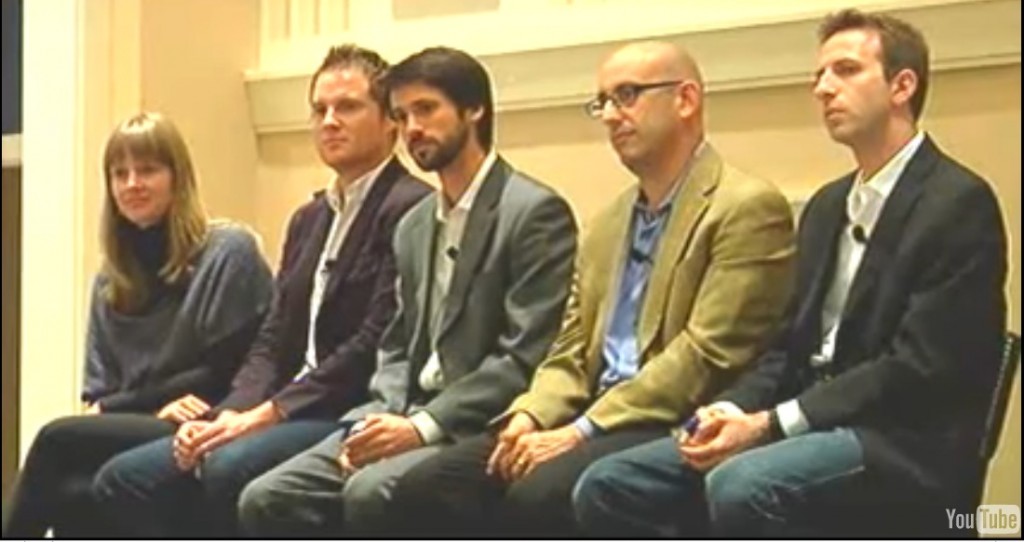InnoTech Conference Teeming With Emerging Trends
October 25, 2011

Sean Lowry, Exe. Dir., Innotech and Carrie Vanston, Co-Author, MINITRENDS at Innotech Conference, Photo by Sloan Foster
I’ve attended the InnoTech Conference and Expo and its associated eMarketing Summit for several years now and always learn a lot. This year I wanted to pass on some comments from experts that I heard yesterday relating to emerging trends that are becoming more and more important:
Sean Lowry, of the very successful InnoTech series, always does a great job of making sure everything runs smoothly. I was even able to steal him for a minute to ask what emerging trends he saw coming. He told me, “I see continued convergence of all the different technologies we are seeing here today. Development of mobile applications and host applications in the cloud are particularly important. There is so much video activity and a lot of it is being hosted in the cloud now.”
I asked Giovanni Galluci, social media expert and Dallas photographer what he thinks the next trend in social media is going to be. He said, “Getting over it. Everyone is burnt out with all the hype and now people are looking for more meaning in social media. Twitter is ridiculous. Those who do marketing are beginning to realize it. Online social media is becoming part of the umbrella of marketing, which is where it belongs. Social media is becoming more commodatized—as in more of a commodity.”
He gave several great hints about Facebook including that Facebook ads are the best way to grow a fan base; Facebook is the 2nd largest search engine, so take advantage of it (including using pictures with metatags, main key words in description, etc.); and put Facebook info on all your printed matter including cards and bills.
I chatted with William Leake, CEO of Apogee Search Marketing, and his take was that “More and more advertising presence is going to be driven by physical location. If you don’t have a physical location strategy, you are going to lose.”
Craig Wax, CEO of Invodo and a video expert, had a lot to say about the future of video marketing. According to Craig, “In the future, no one is going to stand in line anymore. Offline and online is no longer relevant. This is already starting to happen and it is going to become ubiquous.” He added that “QR readers are going to be incorporated into devices and the present obstacles to their use will be chipped away.” (On a side note, Craig was most recently the Senior Vice President and General Manager at Match.com. That had to be an interesting job!)
According to Pat Scherer, Web and Mobile Deployment Manager at The Detail Person, “Mobile space is going to be huge. With the explosion of devices, I think it’s going to make a huge impact on the retail industry. Not only for payments, but for creating local-based experiences utilizing mobile social media. I anticipate this leveling the playing field with e-commerce.”
Finally, I got to chat briefly with siblings Kevin Olsen and Kerri Olsen, Co-Founders of the Austin Grand Prix. Having Formula 1 in Austin exciting!
Cheers,
Carrie Vanston
Media/Marketing Director, Technology Futures, Inc.
Co-Author, MINITRENDS: How Innovators & Entrepreneurs Discover & Profit From Business & Technology Trends
Business Trends for Pets and “Petrepreneurs”
March 16, 2011
 We have covered many business trends on this blog that primarily affect humans, but we have been remiss in documenting trends related to our furry and feathered friends: household pets.
We have covered many business trends on this blog that primarily affect humans, but we have been remiss in documenting trends related to our furry and feathered friends: household pets.
Before you pass the iPad to your pooch, I should explain that these trends are very important to people, too. There are many promising opportunities in “petrepreneurship,” and many businesses that serve the needs of pet providers will need good information on where the market is headed.
Let’s start with a few facts courtesy of the American Pet Products Association. How big is the market? The most recent numbers available are for 2009-2010. It’s estimated that in 2010, Americans spent $47.7 million on their pets. An article on 24/7 Wall St combines that information with U.S. Census data to inform us that, “These expenses have increased from 0.9% of household budgets in 1989 to 1.4% in 2009.” That’s more than a 50% increase in the share of household budgets for pets in the last decade. Sounds like a growth industry to me.
In roughly the same time period, the number of U.S. households with pets has increased from 56% to 62%.
And what kind of pets, exactly, are we talking about? Even though more households have a dog than a cat, cats have the upper paw, with 93.6 million feline pets compared with 77.5 million canines. However, there are more pet fish than cats and dogs combined: 171.7 million of them swimming in American aquariums. Rounding out the menagerie are 15 million birds, 13 million horses, and, yesss, over 13 million reptiles.
According to the report, U.S. Pet Market Outlook 2010-2011: Tapping into Post-Recession Pet Parent Spending, Americans are expected to boost their pet spending to as much as $70 billion by 2014. One of the reasons cited is “a human/animal bond that is possibly stronger than ever as a result of the recession.” The report expects spending to increase on “ethical products,” such as “organic/natural, sustainable, humane, etc.”
The breakdown for the $45.5 billion American spent on their pets in 2009 is as follows:
- Food, $17.56 billion
- Supplies/OTC Medicine, $10.41 billion
- Vet Care, $12.04 billion
- Live Animal Purchases, $2.16 billion
- Pet Services: Grooming & Boarding, $3.36 billion
In an amazing article entitled “Pet Trends for 2011,” Laura Bennett, CEO of Embrace Pet Insurance, examines new developments in pet care, noting that “pet parents will cut back on their own expenses before those of their pets.” Here are some highlights:
- Wal-Mart will continue to roll out pet grooming facilities, competing with pet salons.
- “Disney has finally caught on to the trend of vacationers traveling with their pets, opening the Best Friends Pet Care luxury dog and cat resort right across from the Walt Disney World Resort.”
- Pet insurance will continue to surge in growth. “I expect overall premium growth of 14% in 2011 that will see the US pet insurance industry grow to $374 million in GWP [gross written premiums].”
- “Retailers such as Target and Costco are creeping into the domain of the veterinarian… Will 2011 be the year that the pet pharma market is burst open and veterinary hospitals cede billions of dollars in revenue and profit to the retail giants?”
Bennett goes on to cite five marketing trends for pet products that should sound familiar to readers of the Minitrends Blog — or any other blog on technology trends:
- Social Networking, including exclusive networks for “pet parents”
- Local Shopping Sites, including Yelp, which review pet product providers
- Pet Blogs, including Pet Connection, Pawcurious, and YesBiscuit!
According to Bennett, among the most needed services in the pet products industry (are you listening, petrepreneurs?) is the integration of e-commerce websites and social networking. “I have yet to find anyone in the pet space succeeding on this front,” says Bennett. “I have to say that in 2010, there was a paucity of web development in the pet world — a missed opportunity indeed.”
While humans claw their way out of the recession, their pets continue to consume a greater share of disposable income, along with all those treats. And opportunities continue to appear for individuals and organizations who can see the business trends in the booming pet products industry.
STEVE O’KEEFE
News Editor, Minitrends Blog
Source: “Industry Statistics & Trends,” American Pet Products Association, 2009/2010
Source: “Ten Things Americans Waste the Most Money On,” 24/7 Wall St, Feb. 24, 2011
Source: “U.S. Pet Market Outlook 2010-2011: Tapping into Post-Recession Pet Parent Spending,” Market Reports Online, March 2010
Source: “Pet Trends for 2011,” Embrace Pet Insurance
Image courtesy of LASZLO ILYES, used under its Creative Commons license.
Accenture IT Report Encourages Businesses to Lose Control
February 22, 2011
 Is your business ready to lose control? That appears to be the direction of enterprise computing, according to a new set of predictions just released by management consulting powerhouse, Accenture.
Is your business ready to lose control? That appears to be the direction of enterprise computing, according to a new set of predictions just released by management consulting powerhouse, Accenture.
In the free report, Accenture Technology Vision 2011, Accenture’s information technology (IT) team, led by Kevin Campbell, chief executive of the company’s technology group, reviewed such sources as the subjects of keynote speeches at technology conferences, the types of projects receiving venture capital funding, and the predictions of well known IT experts. These sources are similar to those John and Carrie Vanston recommend consulting when analyzing the viability of trends in their book, MINITRENDS. The Accenture report arrives at a short list of eight trends that are transforming IT.
Accenture sees “a world of IT that barely resembles what enterprise computing looks like today,” according to Gavin Michael, Accenture’s managing director of research and development, as quoted by TMCnet reporter, Rajani Baburajan. “IT is no longer in a support role. Instead, it is front and center driving business performance and enriching people’s lives like never before,” Michael said.
Accenture sees three major rivers running through its predictions:
- Greater Distribution of Data: “Data is dispersed across many more locations, and under the control of far more owners.”
- The Separation of Software and Hardware: “Technology today enables decoupling of entities and layers once deemed inseparable.”
- The Meteoric Rise of Analytics: “Analytics will become the super-tool with which to drive more agile and effective decision-making.”
You have to be something of a mindreader to parse the jargon of the report and glean the pearls of wisdom it contains, but they are there. Accenture sees decentralization at the core of technology trends, such as cloud computing, which we have frequently covered on this blog.
The report’s insight that IT security needs to move from a “fortress mentality” to a layered and distributed series of security checks is prescient, as is the awareness that greater automation in security and the ability of software to handle “noise” will improve results. Imagine how the technology behind IBM’s Watson (the new Jeopardy champion) will enable computers to understand natural language and anticipate security breaches instead of waiting for an attack.
The Accenture report, like most similar surveys, sees the rise of the social platform in enterprise computing. The website will no longer be the primary connection point between an organization and its constituents. Companies will have to set up shop where the consumer is — on sites such as Facebook and Netflix — rather than waiting for the consumer to come to them.
The report concludes with this powerful insight: The primary role of IT in the past has been to reduce an organization’s costs; in the future, it will be to enhance the user experience. The authors of the report foresee technology that goes beyond Apple Computer’s famously intuitive user experience to something that instantly and seamlessly shapes itself to the unique characteristics of the user.
Accenture’s vision is at once thrilling and unsettling. Organizations will have to move out of their bunkers, distributing their computing resources and allowing users to take control. Like a fast-paced, high-tech amusement ride, it’s going to be scary but enjoyable for those entities able to loosen up and cede control of their IT resources to the audiences they are charged with serving.
STEVE O’KEEFE
News Editor, Minitrends Blog
Source: “Accenture Technology Vision 2011” (PDF), Feb. 7, 2011
Source: “Accenture Maps Eight Trends That Will Drive Future of IT,” infoTech Spotlight, Feb. 9, 2011
Image by Mulad (Michael Hicks), used under its Creative Commons license.
What is Social CRM? Major New Tech Trend Takes Hold
February 15, 2011
 If you haven’t heard about “Social CRM” yet, get ready. Predictions are this will be the “technology trend of the year” for 2011.
If you haven’t heard about “Social CRM” yet, get ready. Predictions are this will be the “technology trend of the year” for 2011.
Simply stated, Social CRM is the marriage of your Rolodex with Twitter. The Rolodex represents your Customer Relationship Management system, or CRM: your database of contacts, clients, prospects, employees, customers, or anyone else your organization keeps tabs on. Twitter represents the social side of these contacts, whether they express themselves on Twitter, Facebook, LinkedIn, through comments on blogs, or other ways online.
When you merge your CRM system with social networking, what you get is an amazing lifecycle understanding of how your customers were influenced to contact you, what they purchased once they did, and how those purchases worked out for them. Imagine being able to ask a customer, “How did you find out about us” and “How is that purchase working out for you” without having to ask — and being able to rely on the answers as honest and real. That’s the power of Social CRM.
Social CRM begins when an organization starts to listen to what people are saying about it online, and posts its own messages through social media such as Twitter and Facebook. Social CRM deepens when organizations go beyond watching themselves to watching their customers, employees, and other contacts. According to CRM expert and Inc. magazine reporter, Brent Leary, “2011 looks to be shaping up as the year companies go beyond focusing on marketing and promotion” with Social CRM.
Leary is on the board of the Customer Relationship Management Association and editor of its newsletter, “Insights.” His article for Inc. magazine reviews a conference on Social CRM at the University of Toronto held at the end of last year. The conference was the inaugural event for the new Center for CRM Excellence at the University’s Rotman School of Management. Leary debriefs several experts on Social CRM including Greg Gianforte at RightNow, Marcel LeBrun at Radian6, Alex Bard at Assistly, and John Bastone at SAS.
Social networking gives organizations the opportunity to eavesdrop on contacts as they reveal their opinions through actions and comments online. Social CRM gathers those tidbits of information and combines them into reports about contacts that are far more elaborate than professional profilers ever could have imagined. Social CRM makes it possible to, among other things, fix a customer’s problem before they even know they have a problem, or before they report it. That’s powerful marketing!
Another excellent article comes from Maria Ogneva at Mashable, a site not known for deep articles. Ogneva has an interest in the subject, as the director of social media for Nimble, a social relationship management firm. Still, Ogneva intelligently lays out the fundamentals of Social CRM:
The social customer may go to Twitter with a question, a user forum with a customer service query, Facebook with a compliment, or Yelp with a complaint. The processes you establish will largely determine your ability to respond quickly and with the relevant information, while uniting all of these interactions under one customer record.
If you think Social CRM is just another fad that will soon disappear, maybe Gartner will persuade you otherwise? In a study released this week, the giant IT research firm predicted that Social CRM sales will exceed $1 billion by 2013. Spending on Social CRM is expected to double this year, from 4% to 8% of total CRM spending.
Chris DiMarco, Web Editor for TMCnet, nails the significance of Gartner’s report when he writes, “The utility to include and target individuals based on information they’ve provided voluntarily on social media sites will likely be necessary to compete in the very near future.” In short, if you don’t get Social CRM, you don’t get the customer. And that’s the simple reason Social CRM is shaping up to be the app of the year for 2011.
STEVE O’KEEFE
News Editor, Minitrends Blog
Source: “2011: The Year Social CRM Goes Mainstream,” Inc., December 27, 2010
Source: “Why Your Company Needs to Embrace Social CRM,” Mashable, May 21, 2010
Source: “Gartner Says Spending on Social Software to Support Sales, Marketing and Customer Service Processes Will Exceed $1 Billion Worldwide By 2013,” Gartner news release, February 8, 2011
Source: “Social CRM to Explode in the Immediate Future says Gartner Study,” TMCnet, February 8, 2011
Image by nerissa’s ring, used under its Creative Commons license.
IDC Sees Perfect Storm in Portable Computing
December 8, 2010

On December 2, International Data Corporation (IDC), the giant IT research firm out of Framingham, Massachusetts, released its annual predictions for IT in the coming year. The firm is forecasting a perfect storm for IT: a combination of cloud computing, mobile computing, and social networking that threatens to consign desktop PCs to the storage closet.
The author of the survey is IDC’s chief analyst, Frank Gens, who leads IDC’s 1,000 analysts in 110 countries in tracking IT trends. Summarizing this year’s report, Gens sees a nearly complete transformation in the dominant computing platform:
What really distinguishes the year ahead is that these disruptive technologies are finally being integrated with each other — cloud with mobile, mobile with social networking, social networking with ‘big data’ and real-time analytics. As a result, these once-emerging technologies can no longer be invested in, or managed, as sandbox efforts around the edges of the market. Instead, they are rapidly becoming the market itself and must be addressed accordingly.
As the IDC report ripples through the Internet, different players are examining what it means for the future of computing. At ComputerWorld, Sharon Gaudin comments on the surge in social networking, suggesting that business startups will stop building expensive and complicated websites and opt for free Facebook pages instead.
Anuradha Shukla at TechWorld is enthusiastic about IDC’s upbeat predictions for IT expenditures. The report forecasts a 5.7% increase in outlays over 2010, to $1.6 trillion worldwide. IDC sees half of that spending coming from emerging market countries shrugging off the recession.
At PC World, Patrick Thibodeau focuses on IDC’s prediction that shipments of apps-enabled mobile devices — smartphones and tablets — will surpass shipments of PCs in the next 18 months. Thibodeau points out, however, that shipments of PCs are not declining; rather, they are growing, but not nearly as quickly as mobile devices.
Another prediction that is sure to catch the eye of venture capital firms: Gens says that nearly a third of the major players in social networking will be bought up in the coming year by the likes of Oracle, Microsoft, HP, and IBM, who need to get in the game.
While many others futurists we have covered on the Minitrends blog have made similar predictions about the growth in cloud computing, mobile computing, and social networking, none of them have joined them together with such a powerful vision of a whole new way of working that Frank Gens brings to IDC’s report.
What do you think is coming in 2011? Do you think it will be just more of the same, or the beginning of a totally new platform, as the IDC report speculates? We welcome your comments.
STEVE O’KEEFE
News Editor, Minitrends Blog
Source: “IDC Predicts Cloud Services, Mobile Computing, and Social Networking to Mature and Coalesce in 2011, Creating a New Mainstream for the IT Industry,” IDC Press Release, 12/02/10
Source: “Business will get more social in 2011, IDC says,” ComputerWorld, 12/06/10
Source: “Cloud services, mobile computing and social networking to mature in IT industry,” TechWorld, 12/07/10
Source: “In historic shift, smartphones, tablets to overtake PCs,” PC World, 12/07/10
Photo by davedehetre (David DeHetre), used under its Creative Commons license.
Lundquist: Service Is Top Tech Trend for 2011
December 1, 2010
 December marks the peak season for looking back on trends from the previous year and forward to trends in the coming year. We’d like to start the month at the Minitrends Blog by sharing the forecasts of famous prognosticators in technology trends to see where they are pointing.
December marks the peak season for looking back on trends from the previous year and forward to trends in the coming year. We’d like to start the month at the Minitrends Blog by sharing the forecasts of famous prognosticators in technology trends to see where they are pointing.
First up is Eric Lundquist. Lundquist is a fixture at Ziff Davis Enterprise, where he has ridden the waves of publishing trends as he reports on technology trends. The Harvard-educated scientist began his career as a journalist (you remember what those are, don’t you?), honing his craft as a daily newspaperman. A newspaper is collection of alphabet in ink on paper that was written yesterday, about today, and is worthless tomorrow.
Lundquist joined Ziff Davis back when eWeek was named PC Week, and quickly rose to editor-in chief of that publication. Following his own advice that video is growing as a method of information delivery, Lundquist moved into video production as creator of CIO Insight, a program on The Pulse Network, which combines streaming video with social networking.
In 2009, Lundquist revealed a love-hate relationship in his technology forecast for 2010. Along with the usual suspects (cloud computing, the migration to mobile, etc.), Lundquist expected CIOs to suffer from whiplash as the economy cut their budgets at a time when IT should be growing its budget. He has similar mixed feelings over social networks, seeing them as a growing trend and a growing source of embarrassment for thoughtless executives.
In his new forecast for 2011, the operative word is “service.” Lundquist predicts that most CIOs will have to evaluate and purchase software as a service in 2011. He also sees the rise of “apps” allowing employees to test and choose services rather than the CIO. He sees social networking, tablets, and mobile platforms all working hard to service business and B2B users who need to communicate on closed networks. He concludes his forecast by lauding the Apple Store for its $99/year training service that has created real-world (not virtual) communities of users.
Mixed-in with Lundquist’s predictions for 2011 are some of the usual suspects: the continuing migration to mobile, cloud computing, virtualization, and tablets. Included is his steadfast belief that “video will take a front seat for businesses to provide new product details, showcase executives, and create how-to explanations for their products and services.” Could this be the last time we see Eric Lundquist’s predictions in print? Enjoy the alphabet while you can.
STEVE O’KEEFE
News Editor, Minitrends Blog
Source: “Lundquist’s Top Tech Trends for 2011,” CIO Insight, 11/19/10
Source: “Ten Top Tech Stories of 2009,” CIO Insight, 12/15/09
Source: “CIO Insight,” The Pulse Network
Photo courtesy of fdecomite, used under its Creative Commons license.
Trend of the Year: Social Shopping
November 29, 2010
 In case you hadn’t noticed, this Thanksgiving marked the tipping point of a major new technology trend: Social Shopping. When you combine the spread of social networking, the market penetration of mobile phones, the desperation of retailers to capture more business, and consumers’ love of the deal, you wind up with Social Shopping.
In case you hadn’t noticed, this Thanksgiving marked the tipping point of a major new technology trend: Social Shopping. When you combine the spread of social networking, the market penetration of mobile phones, the desperation of retailers to capture more business, and consumers’ love of the deal, you wind up with Social Shopping.
Richard MacManus, the founder and CEO of ReadWriteWeb, which is consistently one of the best blogs covering Internet technology trends, recently kicked off a series looking back on the top tech trends of 2010. He begins the series by looking at Social Shopping.
In 2010, we’ve seen the rise of so-called ‘social shopping’ services. They rely heavily on technologies such as social networking, crowdsourcing and smart phone scanners. Here we present five of the main social shopping developments of 2010.
MacManus doesn’t just pick five companies to profile, but five different types of Social Shopping technologies. Who knew there were so many? Here are his top picks, along with examples of companies that have been using these technologies to attract consumers:
1. Daily Deals: Companies that send one or more “deal of the day” messages to subscribers. Examples: Groupon, LivingSocial.
2. Real-Time Shopping: These deep discounts might last for only a few minutes or hours or until supplies run out. Example: Woot.
3. Location Check-In Services: These services offer rewards to people who check in frequently or on certain days. Examples: Foursquare, Yelp.
4. Facebook Shopping: MacManus credits Facebook with enabling Social Shopping through deals with Amazon.com and other retailers.
5. Barcode Scanning: Phone apps that allow you to take a picture of a barcode or QR code with your phone, then search for reviews, deals, or other information on the Internet. Examples: RedLaser, ScanLife.
Last week, we wrote about how Google CEO Eric Schmidt revealed a new feature for Android phones that will allow you to skip the barcode photo and just wave your phone near an NFC chip to learn about deals on a product.
If those aren’t enough leads for you to explore the new world of Social Shopping, then take a look at Mashable’s list of 18 Sites for Social Shopping — and don’t forget to look in the comments for another 18 or so!
Happy Holidays!
STEVE O’KEEFE
News Editor, Minitrends Blog
Source: “Top Trends of 2010: Social Shopping,” ReadWriteWeb, 11/15/10
Source: “SHOPPING SPREE: 18 Sites for Social Shopping & Deals,” Mashable, 08/08/07
Photo by Jenelle/Thriving Ink, used under its Creative Commons license.
Blackbaud Videos Reveal Trends in Nonprofit Technology
November 15, 2010

CLICK FOR VIDEO: Panel on Social Media for Nonprofits from the 2010 Blackbaud Conference on Nonprofit Technology
Last week, I broached the topic of how nonprofits are capitalizing on trends in technology to reach constituents through social networking. Today, I’m going to take the discussion up a notch and look at the fountainhead of many tech trends for nonprofits: Blackbaud, Inc.
Blackbaud was founded in 1981 with the purpose of providing technological support to nonprofit organizations. The company’s growth since has been phenomenal. Headquartered in Charleston, South Carolina, Blackbaud now employs more than 2,000 people worldwide. The company went public in 2004 and is traded on the NASDAQ exchange under ticker symbol BLKB.
Shortly after going public, Blackbaud hired Marc Chardon, a former CFO for Microsoft and manager of Microsoft France, as the company’s new president and CEO. Just last week, Blackbaud was named one of Forbes 100 Best Small Companies in America, a ranking based largely on exceptional financial performance.
Blackbaud has become an enormous driver of technology trends in the nonprofit sector. Last month, the company held its annual conference on nonprofit technology, drawing more than 2,200 people to Washington, D.C., for an action-packed program dominated by seminars on social networking.
This month, Blackbaud has made many of these programs available for free viewing on its BlackbaudTV channel on YouTube. These videos are both inspiring and educational for anyone interested in technology trends. Here are some of the highlights:
Global Trends and What They Mean to You
Marc Chardon, President and CEO of Blackbaud
Becoming a Networked Nonprofit: The Road to Effective Use of Social Media
Allison Fine & Beth Kanter, authors of The Networked Nonprofit
Social Media for Nonprofits
Claire Williams Diaz, Social Innovation at Twitter
Noah Everett, Founder of TwitPic
Matthew Mahan, Vice President of Impact at Causes
Geoff Livingston, Co-Founder of Zoetica
Brian Dresher, Mashable (formerly with USA Today)
Social Media: Paint by the Numbers
Holly Ross, Executive Director, NTEN: The Nonprofit Technology Network
The Nonprofit Trust Agent
Chris Brogan, New York Times bestselling co-author of Trust Agents
Most of the videos are an hour long, except for the Chris Brogan interview, which is a five-minute ambush video in the hallway of the conference center. The first video with Marc Chardon is a panel that covers such trends as social media, radical transparency, and the need for nonprofits to demonstrate ROI. The panel on social media for nonprofits is terrific, with presenters limited to five minutes to take their best shots, followed by the audience Q&A.
For access to all the BlackbaudTV videos — including a five-minute interview with Mark Zuckerberg’s engaging and articulate sister, Randi, about five things nonprofits can do to supercharge their Facebook pages — visit the BlackbaudTV page on YouTube.
STEVE O’KEEFE
News Editor, Minitrends Blog
Source: “Blackbaud Conference 2010: 5 Must-See Presentations,” Social Media 4 Nonprofits, 10/24/10
Source: “Reflections from Independent Sector and Blackbaud Conferences,” Beth’s Blog, 10/26/10.
Nonprofits Take Social Networking to New Heights
November 12, 2010
 Social networking is a megatrend that has been gaining momentum since bulletin boards first made it possible for people to schmooze online in the 1980s. Out of this megatrend have come numerous Minitrends that investors have profitably mined over the past five years, including social bookmarking, tagging, and location-based networks such as Foursquare.
Social networking is a megatrend that has been gaining momentum since bulletin boards first made it possible for people to schmooze online in the 1980s. Out of this megatrend have come numerous Minitrends that investors have profitably mined over the past five years, including social bookmarking, tagging, and location-based networks such as Foursquare.
Steve Monfort, a writer for NASDAQ.com, recently reported on the growing trend of small businesses hiring more people to handle social media:
A recent American Express survey shows that 40 percent of small businesses are using social networking to promote their offerings, up from 10 percent a year ago.
While small businesses are just warming-up to social networking, nonprofit organizations were among the earliest to embrace the trend. By now, everyone has heard about “text-to-give,” which was used by the American Red Cross to collect $30 million from cellphone users for earthquake relief in Haiti last year. According to nonprofit tech guru Tonia Zampieri, sales and marketing manager for LoyaltyClicks, a division of Smart Online, text-to-give is so 2009.
Smart Online recently conducted a survey into technology trends for nonprofit organizations. The results were reported on NTEN, the Nonprofit Technology Network, just a few days ago. They indicate that over 90% of nonprofits actively use social networking (compared with only 40% of small businesses, according to American Express). The breakdown: 91% use Facebook, 63% use Twitter, 45% use YouTube, and 35% use LinkedIn.
You would think that level of penetration would be cheered by the nonprofit experts at LoyaltyClicks. But Zampieri has found a weakness in charity tech: mobile myopia. She writes:
[O]nly 16% of the surveyed nonprofits plan on having mobile websites in 2011, while 19% plan on having smartphone applications.
Zampieri cites a Nielson study that almost one-quarter of the time people are online is spent using social networks — and that half of that social networking is done with mobile devices. Then she provides “compelling reasons why a mobile website or a mobile application might work better for your organization” than, for example, old-fashioned text-to-give:
- donations aren’t limited to $5 or $10
- donations are received immediately
- you capture and control crucial data about your donors
- any size charity can use this technology, not just giants
- it’s a permanent tool, not just a one-shot appeal
For inspiring examples about the way nonprofit organizations are innovating with social networking, we recommend a recent Mashable story on “5 Must-Follow Non-Profits Making a Difference With Social Media.” The article is a run-up to the annual Mashable Awards which will be held January 6, 2011, at the Consumer Electronics Show (CES) in Las Vegas.
I was particularly impressed by the way the Brooklyn Museum has made use of a wide variety of social networking Minitrends to engage visitors and benefactors both online and in person. The museum has a dedicated mobile site (LoyaltyClicks would approve) that allows browsers to tag the museum’s 94,000 piece collection, making it easier for visitors to locate must-see art based on other patrons’ comments. They also use Foursquare to provide restaurant suggestions and other ideas to fill out a trip to the museum.
If you have any other examples of nonprofits who are making innovative uses of social networking applications, we’d like to hear about them. And so would Mashable! The Mashable Awards are open for nomination until November 29.
STEVE O’KEEFE
News Editor, Minitrends Blog
Source: “Job growth anticipated in cloud computing, apps, social media,” NASDAQ.com News, 10/15/10
Source: “Technology Trends for Nonprofits in 2011,” NTEN, the Nonprofit Technology Network, 11/08/10
Source: “5 Must-Follow Non-Profits Making a Difference With Social Media,” Mashable, 11/06/10
Image courtesy of Lisa Brewster, used under its Creative Commons license.
Information Security Victim to IT Trends
November 9, 2010

Lured by the prospect of reduced costs, more companies are putting their information assets at risk by embracing technology trends such as cloud computing. A new survey finds that companies are failing to assess these risks and take defensive measures.
Consulting giant Ernst & Young released its 13th annual Global Information Security Survey last week, and the privacy picture that emerges is not good. The Vancouver Sun summarizes the findings this way:
Less than a third of global businesses have an IT risk management program capable of addressing the risks related to the use of new technologies… In spite of the rapid emergence of new technology, just one in ten companies consider examining new and emerging IT trends a very important activity for the information security function to perform.
What are the IT trends eroding information security at major corporations?
Mobile Computing, including smartphones, tablets, and laptop computers: “Devices that can contain information are increasingly prevalent; they are used for both work and home purposes, blurring the lines between the two, and results in ceding of control over the devices and the information to employees, service providers and others.”
Cloud Computing, including Software-as-a-Service (SaaS): “While organizations may have chosen in the past to avoid cloud technologies and the possible privacy and security challenges they bring about, in this economic climate, the cost reduction benefits that such solutions offer have brought many organizations to reassess whether these transformational technologies are right for them.”
Social Networking and other “Web 2.0” technologies: “60% perceive increased risk from the use of social networking.”
In their new book, MINITRENDS, John and Carrie Vanston cite increased interest in privacy as one of the most promising areas for entrepreneurial activity in the coming two-to-five years:
In general, communications and computer technologies designed to gather personal information have progressed more rapidly and dramatically than those designed to protect this information. Serious efforts are being expended, however, to develop protection technologies.
The authors suggest some of the avenues for Minitrend development, including making it easier for employees to use privacy-protection software and teaching employees how to protect sensitive information. This insight is bolstered by the Ernst & Young report, in which a whopping 92% of respondents indicate that employee awareness of security issues is a problem.
Information security was a lot easier when it was a matter of protecting the perimeter around a company’s information assets. But in today’s economy, those information assets are widely distributed and stored in the hands of employees and outside vendors, making it much more difficult for organizations to protect them. Clearly, Ernst & Young’s shocking report shows tremendous opportunity for innovators and entrepreneurs who can develop technological solutions to modern privacy problems.
STEVE O’KEEFE
News Editor, Minitrends Blog
Source: “Ernst & Young Report Reveals Companies Unprepared to Address Risks Created by New Technology,” The Vancouver Sun, 11/04/10
Source: “Top privacy issues for 2010,” Ernst & Young, 02/10
Source: “Emerging Technology Trends Increase Risks of Protecting Corporate Information,” PR Newswire, 11/04/10
Source: MINITRENDS: How Innovators & Entrepreneurs Discover & Profit From Business & Technology Trends, Technology Futures, Inc., p. 95.
Photo by D. Sharon Pruitt (Pink Sherbet Photography), used under its Creative Commons license.


